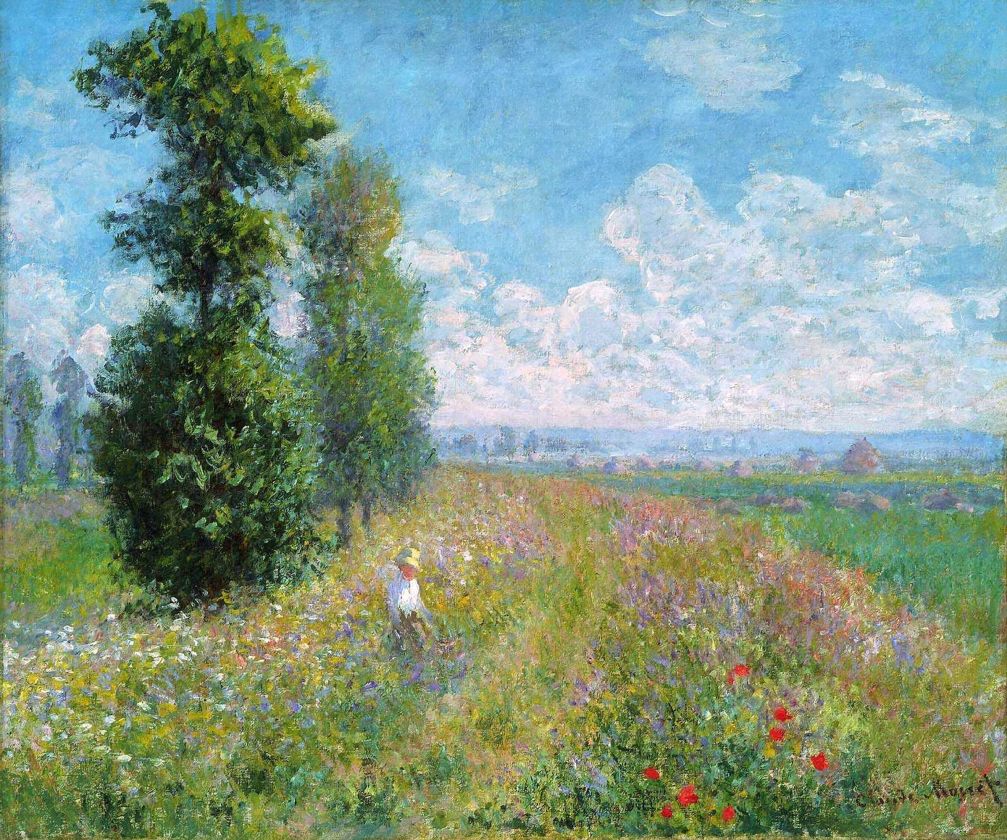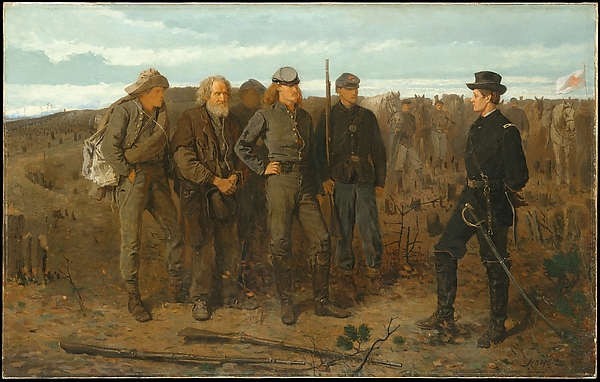While the Romantic Era was home to quite a few varying styles of art, my most and least favorite styles were impressionistic and realistic, respectively.

Claude Monet has always been one of the few artists that I’ve known about and enjoyed, though that may have more to do with the book, “Linnea in Monet’s Garden,” than anything else.
This piece is called, “Meadow with the Poplars,” painted in 1875. Monet does a fantastic job of capturing the defining features of an impressionistic painting – loose brush strokes, lots of dabs of color that blend together well, and the essence of a whimsical, fleeting moment. The use of short, loose brush strokes and the lack of strong, defined lines helps to add to the whimsical, idealized feel of the piece. He also uses contrasting colors to bring a distinct highlight to the colors in the foreground of the painting, using red and green, and purple and yellow. (Museum of Fine Arts)
The bright colors and warm feel that this piece, and most of Monet’s pieces, contain make it one piece that I would actually enjoy having in my home. I think that the impressionistic style brings a lightheartedness and genuinely innocent feel to the medium they’re created on, and they are a sure fire way to brighten a room.

On the other hand, we have Winslow Homer, the Realist painter. This piece, “Prisoners from the Front,” painted in 1866. Where impressionistic pieces are colorful and bright, realistic pieces are very nontheatrical and ordinary in subject matter. Drawing his inspiration from real events that occurred during his time as an artist-correspondent during the Civil War. (Metropolitan Museum of Art)
Going along with the absence of the theatricality within the piece, the background is meant to depict the battlefield of Pittsburgh, Pennsylvania where the subject, Brigadier General Francis Channing Barlow captured several Confederate soldiers. While this is a real event taking place during wartime, the neutral color scheme adds to the non-idealized depiction of what took place. The art has not been embellished with excessive colors or eye grabbing action, it is a simple retelling of what took place. (Winslow Homer)
I feel like the Realist style is about as close as you can get to an exact opposite style of the Impressionist style. Where the Impressionist style brings bright, colorful, idealistic scenery, the Realist style brings drab, neutral-colored, pizzazz-less images. Where the Impressionistic style brightens a room and makes it more enjoyable, the Realist style works to keep the mood much more somber. I don’t think that a Realist piece such as this is one that I would ever have in my home.
Works Cited
“Meadow with Poplars.” Museum of Fine Arts, Boston, 16 May 2017, http://www.mfa.org/collections/object/meadow-with-poplars-32061.
“Prisoner’s from the Front.” Metropolitan Museum of Art, http://www.metmuseum.org/art/collection/search/11133.
I am seeing if I can see my old comment. You can easily delete this.
LikeLike
Whimsical is the perfect word, in my mind, for Monet’s paintings. I truly enjoy the almost aliveness of his paintings in their feel versus their details. Impressionism is one of my favorite styles that we have learned about so far and I definitely prefer it over romanticism. One interesting thing to me about this era is that it doesn’t focus on religious content like so many previous eras. This is definitely a shift that I enjoy, I am much more interested in art that gives insight into societies and people than glorifies religious entities and concepts. Impressionism does this exceptionally well too because it is about capturing a moment in time through a person’s eyes instead of almost being through a camera lens.
LikeLike
Wow! What beautiful pieces you have chosen. You made some interesting points about the Impressionism and the Realist styles. I do agree that they seem to be complete opposites. It is interesting because I would usually say that I prefer the Realist style, yet in the paintings presented, I really enjoy the picture by Claude Monet because of its fanciful appearance. Also, I love the unique colors in the painting. Although I am usually not a fan of loose brushstrokes, I admire them in this painting. I do not know if I would want to own this painting, but it is unique. This scene almost makes me feel as if I was in the painting in a summer haze. I was interested to find out more about Claude Monet, so I found this article which talks about his life and art style. http://www.theartstory.org/artist-monet-claude.htm
LikeLike
Sorry about the post above. I was signed into my other blog account and did not realize until I had already posted. Wow! What beautiful pieces you have chosen. You made some interesting points about the Impressionism and the Realist styles. I do agree that they seem to be complete opposites. It is interesting because I would usually say that I prefer the Realist style, yet in the paintings presented, I really enjoy the picture by Claude Monet because of its fanciful appearance. Also, I love the unique colors in the painting. Although I am usually not a fan of loose brushstrokes, I admire them in this painting. I do not know if I would want to own this painting, but it is unique. This scene almost makes me feel as if I was in the painting in a summer haze. I was interested to find out more about Claude Monet, so I found this article which talks about his life and art style. http://www.theartstory.org/artist-monet-claude.htm
LikeLike
Great comparison between Impressionism and Realism! I also found myself more interested in pieces similar to Monet’s with their visible brush strokes. The texture created by these large strokes really adds to the lighthearted feel of the painting. The major difference I had noticed between Impressionism based styles and realist is the level of detail between. Realist paintings try to portray a lot of details, however I noticed that in many of these paintings that there are areas that don’t get nearly the attention as the focal area. I found this jarring and hard to ignore. Impressionism paintings go the opposite direction and avoid any definite detail which in turn put its on the viewer’s mind to ‘fill in the gaps’ and create the detail for themselves. As such I feel like Impressionism pieces are far more interactive and can vary between person to person.
LikeLike